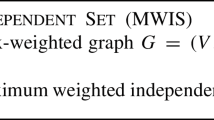Abstract
Given a graph G=(V,E), the independent set problem is that of finding a maximum-cardinality subset S of V such that no two vertices in S are adjacent. We introduce two fast local search routines for this problem. The first can determine in linear time whether a maximal solution can be improved by replacing a single vertex with two others. The second routine can determine in O(mΔ) time (where Δ is the highest degree in the graph) whether there are two solution vertices than can be replaced by a set of three. We also present a more elaborate heuristic that successfully applies local search to find near-optimum solutions to a wide variety of instances. We test our algorithms on instances from the literature as well as on new ones proposed in this paper.


Similar content being viewed by others
Explore related subjects
Discover the latest articles, news and stories from top researchers in related subjects.Notes
Standard doubly-linked lists will do, but updating them is nontrivial. In particular, when removing a vertex x from the solution, we must be able to remove in constant time the entry representing x in the list of each neighbor v. This can be accomplished by storing a pointer to that entry together with the arc (x,v) in x’s adjacency list.
Due to an implementation issue, a preliminary version of this paper (Andrade et al. 2008) incorrectly stated that the 3-improvement local search could seldom improve 2-maximal solutions. As the tables show, this is not true: 3-improvements are found quite often.
The standard deviation is not always a good measure of regularity. Despite being highly regular, gameguy has a triangulation pattern in which roughly half the vertices have degree 4 and half have degree 8, leading to a standard deviation higher than 2.
References
Andrade, D.V., Resende, M.G.C., Werneck, R.F.: Fast local search for the maximum independent set problem. In: McGeoch, C.C. (ed.) Proc. 7th International Workshop on Experimental Algorithms (WEA), vol. 5038, pp. 220–234. Springer, Berlin (2008)
Battiti, R., Protasi, M.: Reactive local search for the maximum clique problem. Algorithmica 29(4), 610–637 (2001)
Bomze, I.M., Budinich, M., Pardalos, P.M., Pelillo, M.: The maximum clique problem. In: Du, D.Z., Pardalos, P.M. (eds.) Handbook of Combinatorial Optimization (Sup. Vol. A), pp. 1–74. Kluwer Academic, Norwell (1999)
Butenko, S., Pardalos, P.M., Sergienko, I., Shylo, V., Stetsyuk, P.: Finding maximum independent sets in graphs arising from coding theory. In: Proceedings of the 2002 ACM Symposium on Applied Computing, pp. 542–546 (2002)
Butenko, S., Pardalos, P.M., Sergienko, I., Shylo, V., Stetsyuk, P.: Estimating the size of correcting codes using extremal graph problems. In: Pearce, C. (ed.) Optimization: Structure and Applications. Springer, Berlin (2008)
Demetrescu, C., Goldberg, A.V., Johnson, D.S.: 9th DIMACS Implementation Challenge: Shortest Paths (2006). http://www.dis.uniroma1.it/~challenge9. Last visited on March 15, 2008
Feo, T., Resende, M.G.C., Smith, S.: A greedy randomized adaptive search procedure for maximum independent set. Oper. Res. 42, 860–878 (1994)
Grosso, A., Locatelli, M., Della Croce, F.: Combining swaps and node weights in an adaptive greedy approach for the maximum clique problem. J. Heuristics 10, 135–152 (2004)
Grosso, A., Locatelli, M., Pullan, W.: Simple ingredients leading to very efficient heuristics for the maximum clique problem. J. Heuristics 14(6), 587–612 (2008)
Hansen, P., Mladenović, N., Urošević, D.: Variable neighborhood search for the maximum clique. Discrete Appl. Math. 145(1), 117–125 (2004)
Johnson, D.S., Trick, M. (eds.): Cliques, Coloring and Satisfiability. DIMACS Series in Discrete Mathematics and Theoretical Computer Science, vol. 26. AMS, Providence (1996)
Karp, R.: Reducibility among combinatorial problems. In: Miller, R., Thatcher, J. (eds.) Complexity of Computer Computations, pp. 85–103. Plenum, New York (1972)
Katayama, K., Hamamoto, A., Narihisa, H.: An effective local search for the maximum clique problem. Inf. Process. Lett. 95, 503–511 (2005)
Lourenço, H.R., Martin, O., Stützle, T.: Iterated local search. In: Glover, F., Kochenberger, G. (eds.) Handbook of Metaheuristics, pp. 321–353. Kluwer Academic, Norwell (2003)
Pullan, W.J., Hoos, H.H.: Dynamic local search for the maximum clique problem. J. Artif. Intell. Res. 25, 159–185 (2006)
Richter, S., Helmert, M., Gretton, C.: A stochastic local search approach to vertex cover. In: Proceedings of the 30th German Conference on Artificial Intelligence (KI), pp. 412–426 (2007)
Sander, P.V., Nehab, D., Chlamtac, E., Hoppe, H.: Efficient traversal of mesh edges using adjacency primitives. ACM Trans. Graph. 27(5), 144:1–144:9 (2008)
Sloane, N.J.A.: Challenge problems: Independent sets in graphs (2000). http://www.research.att.com/~njas/doc/graphs.html. Last visited on March 15, 2008
Xu, K.: BHOSLIB: Benchmarks with hidden optimum solutions for graph problems (2004). http://www.nlsde.buaa.edu.cn/~kexu/benchmarks/graph-benchmarks.htm. Last visited on March 15, 2008
Acknowledgements
We thank Diego Nehab and Pedro Sander for sharing their paper and providing us with the MESH instances. We are also grateful to Manuel Holtgrewe for pointing out a few minor issues with the version of our code we used in the preliminary version of this paper (Andrade et al. 2008). In particular, some vertex scans of ILS were not counted properly, which affected its stopping criterion.
Author information
Authors and Affiliations
Corresponding author
Additional information
Part of this work was done while D.V. Andrade was at Rutgers University. Part of this work was done while R.F. Werneck was at Princeton University.
Rights and permissions
About this article
Cite this article
Andrade, D.V., Resende, M.G.C. & Werneck, R.F. Fast local search for the maximum independent set problem. J Heuristics 18, 525–547 (2012). https://doi.org/10.1007/s10732-012-9196-4
Received:
Accepted:
Published:
Issue Date:
DOI: https://doi.org/10.1007/s10732-012-9196-4




